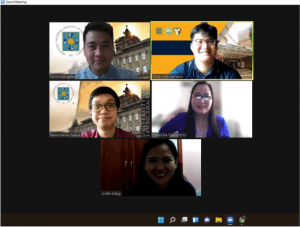The application of phages as well as the importance of identification and conservation of plants were highlighted during the 4th Online Graduate Seminar Lecture presentation of the students from the Natural Sciences Cluster of the UST Graduate School. The webinar was held on December 17, 2021 via Zoom.


The lectures were delivered by Ms. Criselda P. Francisco, Ms. Jenifer Dalog, Mr. Justin Paolo B. Abengaña, and Mr. Ramon Arvin Noriel Santos. Graduate School (GS) Seminar Coordinator Dr. Dino T. Tordesillas, delivered the welcome remarks while College of Science Dean and GS Natural Sciences Cluster Program Lead Dr. Rey Donne S. Papa, delivered the opening remarks. The first lecture, presented by Francisco, was about floral diversity, diversity assessment, ethnobotanical survey, and policy assessment on plant conservation.
The City of San Fernando, La Union (CSFLU), Philippines, according to Francisco, serves as the economic and political city center of the province and the regional center of the Ilocos Region (Region I) in the country in which its growth as a component city is rapid and unstoppable. It takes a significant step towards achieving its vision to become a Smart City by year 2025. A smart city can deliver a peaceful and smart economy, a healthy and smart living and more importantly, a smart and clean environment. To achieve its vision of becoming a Smart City by year 2025, the local government or LGU of the CSFLU needs help in terms of information on plant composition and diversity assessment, as well, Francisco explained. A smart and clean environment, in its entirety, must be sustainable in terms of its natural resources such as flora. Considering the proximity of 2025, there is an urgency and need to take part in achieving the CSFLU’s goal of becoming a Smart City by year 2025.
Francisco also acknowledged that her target study is a related research of the INFLORAS, the abbreviated form for Integrated Floristic Assessment in Vulnerable Coastal Vegetation of San Fernando City, La Union, Philippines program,” a newly approved research grant to be funded by the National Research Council of the Philippines. GS faculty members Asst. Prof. Nikki Heherson A. Dagamac, Dr.rer.nat., Program Leader and co-advisor, and Prof. Cecilia Banag-Moran Dr.rer.nat., Project Leader and advisor, are Francisco’s professors. A MOA signing in the CSFLU was held online on May 18, 2021 where the INFLORAS program was already approved by its LGU. Dalog, the second presenter, discussed the DNA barcodes of tree species in the Philippines. According to her, the public can gain access to the ecological system because of the established DNA barcode library.
Unfortunately, she mentioned that molecular identification and authentication of forest trees and woody plants appear to be lacking in the country. With the Philippines’ ongoing extensive logging and agricultural growth, strict monitoring and conservation measures are required, which can be effectively implemented once vulnerable tree species have been accurately identified and authenticated, dalog stressed. Stating that creating a barcode library for tree species is necessary, Dalog, explained that its creation will be necessary to solve cryptic or poorly identified species, as well as to provide references that would aid in the identification of threatened and vulnerable species. She indicated that it would help ensure the conservation and preservation of threatened species as well as forest management. The third lecture was delivered by Abengaña, who discussed the “Significance and Potential of Local Biological Control Studies in the Agricultural Sector.” In his paper, he emphasized the need for local research topics focusing on studying the diversity of bacterial phytopathogens infecting local food crops and finding novel biological control agents to combat its disease manifestation and to prevent further spread of these phytopathogens. To possibly achieve this goal, Abengaña said that the use of bacterial viruses known as bacteriophages can help accomplish this.
By doing so, some of the areas of development for local bacteriophage research shall be addressed such as (1) focusing more on alternative uses of bacteriophage aside from the medical and food aspects; (2) discovery of other novel phage strains specific for bacterial phytopathogens; (3) possible establishment of a local bacteriophage culture collection; (4) and also, molecular typing of local bacteriophage strains for possible environmental tracking. Abengaña explained that this research may also serve as a baseline study in the Philippines for its potential use for the local agricultural setting and shall provide a general assessment of different phytopathogen strains that are apparent on local agricultural crops, especially for tomato plants. This may also possibly, in the near future, serve as a collection of various phage strains, establishment of local phage strain culture collection, specific for disease- causing phytopathogens shall also be obtained as a result of these types of studies.
In the presentation by Santos, he discoursed on bacteriophages and how they can be used to improve food safety. He presented a general overview on phages and discussed how the use of phages to control bacterial pathogens in foods is still relatively recent compared to their therapeutic use. He mentioned the advantages such as their high specificity, ability to adapt to phage resistance, and their relatively low cost to isolate and propagate. Santos also talked about the limitations of using phages as biocontrol agents of food such as consumer acceptance and that not all phages are suitable for therapeutic use. He then briefly discussed the current studies done here in the Philippines as well as an overview of his dissertation experiments.




